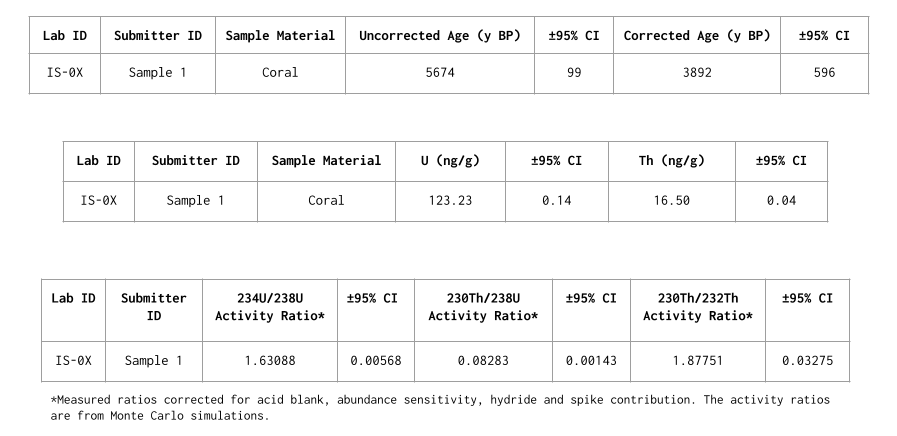Methodology: U-Th Dating
Pretreatment
Samples are digested and then screened for uranium and thorium. Uranium and thorium are separated from the matrix elements by means of extraction chromatography using Eichrom UTEVA cation exchange resin following the method of Pourmand et al. (2013).
U-Th Dating Equipment
Device: Neptune Plus multi-collector inductively coupled plasma mass spectrometer (MC-ICP-MS) with an Apex-Q desolvation nebulizer. A comprehensive data reduction and uncertainty propagation algorithm is also performed following the methodology in Pourmand et al., 2013.
U-Th Dating Results
U-Th dates are reported as years before present (y B.P.). The analytical accuracy and precision for uranium and thorium were assessed by multiple measurements of certified reference material CRM-112A and IRMM-035 respectively during the analysis. Uncertainties on the U-Th ages are reported at the 95% confidence interval (CI).


Plot of 234U/238U activity ratios against 230Th/238U activity ratios, modified after Osmond and Ivanovich (1992).
Duration: 2 minutes, 1 second || Speaker: Maren Pauly, PhD
This video excerpt is part of Isobar Science’s webinar: An Introduction to An Introduction to Uranium-Thorium Dating.
Disclaimer: This video is hosted in a third-party site and may contain advertising.
References
Osmond, J. K. & Ivanovich, M. (1992). Uranium-series mobilization and surface hydrology. In (M. Ivanovich & R. S. Harmon, Eds), Uranium-series disequilibrium: applications to earth. marine and environmental sciences. Clarendon Press 2nd edition, Oxford, Chap. 8, pp. 259–289.
Pourmand, A., Tissot, F.L., Arienzo, M. and Sharifi, A., (2013). Introducing a comprehensive data reduction and uncertainty propagation algorithm for U‐Th geochronometry with extraction chromatography and isotope dilution MC‐ICP‐MS. Geostandards and Geoanalytical Research, 38(2), pp.129-148. DOI: 10.1111/j.1751-908X.2013.00266.x
Page last updated: November 2019
